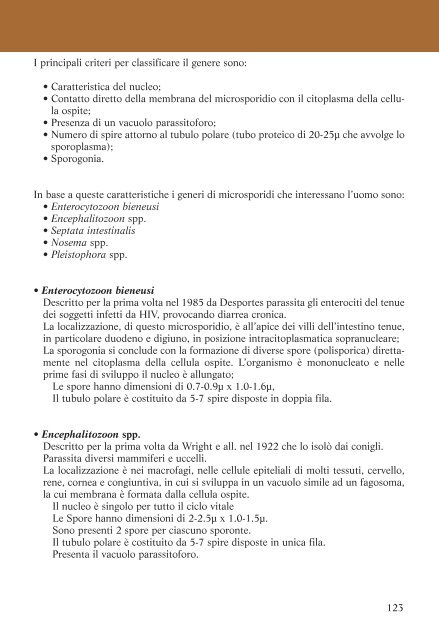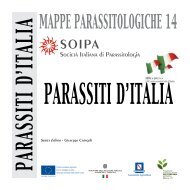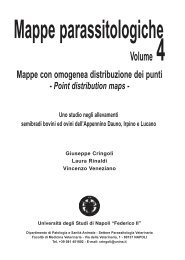La Diagnosi di Laboratorio delle Malattie da Protozoi - tutte mappe
La Diagnosi di Laboratorio delle Malattie da Protozoi - tutte mappe
La Diagnosi di Laboratorio delle Malattie da Protozoi - tutte mappe
You also want an ePaper? Increase the reach of your titles
YUMPU automatically turns print PDFs into web optimized ePapers that Google loves.
I principali criteri per classificare il genere sono:<br />
• Caratteristica del nucleo;<br />
• Contatto <strong>di</strong>retto della membrana del microspori<strong>di</strong>o con il citoplasma della cellula<br />
ospite;<br />
• Presenza <strong>di</strong> un vacuolo parassitoforo;<br />
• Numero <strong>di</strong> spire attorno al tubulo polare (tubo proteico <strong>di</strong> 20-25µ che avvolge lo<br />
sporoplasma);<br />
• Sporogonia.<br />
In base a queste caratteristiche i generi <strong>di</strong> microspori<strong>di</strong> che interessano l’uomo sono:<br />
• Enterocytozoon bieneusi<br />
• Encephalitozoon spp.<br />
• Septata intestinalis<br />
• Nosema spp.<br />
• Pleistophora spp.<br />
• Enterocytozoon bieneusi<br />
Descritto per la prima volta nel 1985 <strong>da</strong> Desportes parassita gli enterociti del tenue<br />
dei soggetti infetti <strong>da</strong> HIV, provocando <strong>di</strong>arrea cronica.<br />
<strong>La</strong> localizzazione, <strong>di</strong> questo microspori<strong>di</strong>o, è all’apice dei villi dell’intestino tenue,<br />
in particolare duodeno e <strong>di</strong>giuno, in posizione intracitoplasmatica sopranucleare;<br />
<strong>La</strong> sporogonia si conclude con la formazione <strong>di</strong> <strong>di</strong>verse spore (polisporica) <strong>di</strong>rettamente<br />
nel citoplasma della cellula ospite. L’organismo è mononucleato e nelle<br />
prime fasi <strong>di</strong> sviluppo il nucleo è allungato;<br />
Le spore hanno <strong>di</strong>mensioni <strong>di</strong> 0.7-0.9µ x 1.0-1.6µ,<br />
Il tubulo polare è costituito <strong>da</strong> 5-7 spire <strong>di</strong>sposte in doppia fila.<br />
• Encephalitozoon spp.<br />
Descritto per la prima volta <strong>da</strong> Wright e all. nel 1922 che lo isolò <strong>da</strong>i conigli.<br />
Parassita <strong>di</strong>versi mammiferi e uccelli.<br />
<strong>La</strong> localizzazione è nei macrofagi, nelle cellule epiteliali <strong>di</strong> molti tessuti, cervello,<br />
rene, cornea e congiuntiva, in cui si sviluppa in un vacuolo simile ad un fagosoma,<br />
la cui membrana è formata <strong>da</strong>lla cellula ospite.<br />
Il nucleo è singolo per tutto il ciclo vitale<br />
Le Spore hanno <strong>di</strong>mensioni <strong>di</strong> 2-2.5µ x 1.0-1.5µ.<br />
Sono presenti 2 spore per ciascuno sporonte.<br />
Il tubulo polare è costituito <strong>da</strong> 5-7 spire <strong>di</strong>sposte in unica fila.<br />
Presenta il vacuolo parassitoforo.<br />
123





